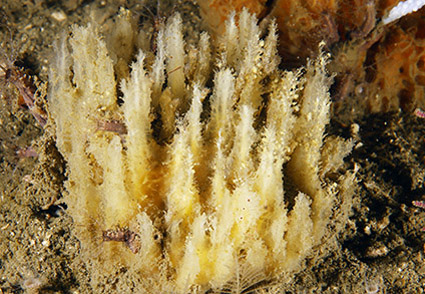Abstract
The genus Biemna currently includes fifty-eight valid species distributed worldwide with a wide depth range. In this paper, we describe a new species of this genus, Biemna begonae sp. nov., collected by scuba diving in two different locations on the Galician coast (NW Spain). The typical skeleton of this group is composed by megascleres arranged in a plumose or plumoreticulate fashion, with ectosomal skeleton constituted by brushes of choanosomal tracts and microscleres, including sigmata, commata and raphides. The habitus of the new species is a hemispherical cushion-shaped with numerous tubular projections emerging from the base, ending in oscules, and a general burgundy-red or whitish cream colour in live specimens. Spicules are styles, rare rhabdostyles, four size classes of sigmata, and raphides. The new species is compared morphologically with the other European representatives of the genus.
References
- Alcolado, P.M. & Gotera, G.G. (1986) Nuevas adiciones a la fauna de poriferos de Cuba (New additions to the poriferan fauna of Cuba). Poeyana, 331, 1–19.
- Álvarez, I., Prego, R., de Castro, M. & Varela, M. (2012) Galicia upwelling revisited: out-of-season events in the rias (1967– 2009). Ciencias Marinas, 38, 143–159. https://doi.org/10.7773/cm.v38i1B.1776
- Bañón, R. & Villalba, A. (2017) Inventario de la biodiversidad marina de Galicia: Proyecto LEMGAL. Consellería do Mar, Xunta de Galicia, 570 pp. [ISBN-13: 978-84-453-5293-9]
- Cristobo, J., Urgorri, V., Solorzano, M.R. & Ríos, P. (1993) Métodos de recogida, estudio y conservación de las colecciones de poríferos. In: Thomas, B., Palacios, F. & Martínez, M.C. (Eds.), International Symposium and First World Congress on Preservation and Conservation of Natural History Collection. Vol. 2. Comunidad de Madrid, Madrid, pp. 277–287.
- Durán, C. & Solórzano, M. (1982) Aportaciones al conocimiento del macrozoobentos de la zona infralitoral rocosa de Galicia mediante la utilización de la escafandra autónoma: I Desmosponjas. Trabajos Compostelanos de Biología, 9, 49–67.
- Ferrer-Hernandez, F. (1914) Esponjas del Cantábrico. Parte 2ª. III. myxospongida. IV. Tetraxonida. V.Triaxonida. Trabajos del Museo Nacional de Ciencias Naturales, Serie Zoológica, 17, 1–46.
- GBIF.org (2023) GBIF Occurrence Download. Available from: https://doi.org/10.15468/dl.csjhxy (accessed 19 September 2023)
- Hajdu, E. & Van Soest, R.W.M. (2002) Family Desmacellidae Ridley & Dendy, 1886. In: Hooper, J.N.A. & Van Soest, R.W.M. (Eds.), Systema Porifera. A guide to the classification of sponges. Vol. 1. Kluwer Academic/Plenum Publishers, New York/Boston/Dordrecht/London/Moscow, pp. 642–650. https://doi.org/10.1007/978-1-4615-0747-5_69
- Howell, K.L., Piechaud, N., Downie, A.L. & Kenny, A. (2016) The distribution of deep-sea sponge aggregations in the North Atlantic and implications for their effective spatial management. Deep Sea Research Part I: Oceanographic Research Papers, 115, 309–320. https://doi.org/10.1016/j.dsr.2016.07.005
- Maldonado, M. (1992) Demosponges of the red coral bottoms from the Alboran Sea. Journal of Natural History, 26, 1131–1161. https://doi.org/10.1080/00222939200770661
- Morrow, C.C., Redmond, N.E., Picton, B.E., Thacker, R.W., Collins, A.G., Maggs, C.A., Sigwart, J.D. & Allcock, A.L. (2013) Molecular Phylogenies Support Homoplasy of Multiple Morphological Characters Used in the Taxonomy of Heteroscleromorpha (Porifera: Demospongiae). Integrative and Comparative Biology, 53, 428–446. https://doi.org/10.1093/icb/ict065
- Morrow, C. & Cárdenas, P. (2015) Proposal for a revised classification of the Demospongiae (Porifera). Frontiers in Zoology, 12, 1–27. https://doi.org/10.1186/s12983-015-0099-8
- Pérez-Dieste, J. & Almón, B. (2021) n.k. In: Pérez, J. (Ed.), Fauna Marina Atlántica: Esponjas del Litoral de Galicia. Solucións Gráficas, S.L., Boiro, A Coruñ, 268 pp. [Depósito legal: C 31–2021]
- Rützler, K. (1978) Sponges on coral reef. In: Stoddart, D.R. & Johanness, R.E. (Eds.), Coral reefs: research methods. Unesco, Paris, pp. 81–120.
- Solórzano, M.R. (1990) Poríferos del litoral gallego: estudio faunístico, distribución e inventario. PhD Thesis, Unversidad de Santiago de Compostela, Santiago, 1036 pp.
- Solórzano, M.R. (1991) Inventario dos Poríferos do litoral galego (Porifera). Cadernos de Area de Ciencias Biolóxicas (Inventarios). Seminario de Estudos Galegos. Vol. VII. Ediciós do Castro, O Castro-Sada, A Coruña, 54 pp.
- de Voogd, N.J., Alvarez, B., Boury-Esnault, N., Carballo, J.L., Cárdenas, P., Díaz, M.C., Dohrmann, M., Downey, R., Hajdu, E., Hooper, J.N.A., Kelly, M., Klautau, M., Manconi, R., Morrow, C.C., Pisera, A.B., Ríos, P., Rützler, K., Schönberg, C., Vacelet, J. & van Soest, R.W.M. (2023) World Porifera Database. Biemna Gray, 1867. Available from: https://www.marinespecies.org/porifera/porifera.php?p=taxdetails&id=131897 (accessed 3 October 2023)
- Ríos, P. & Cristobo, J. (2006) A new species of Biemna (Porifera: Poecilosclerida) from Antarctica: Biemna strongylota. Journal of the Marine Biological Association of the United Kingdom, 86, 949–955. https://doi.org/10.1017/S0025315406013919


